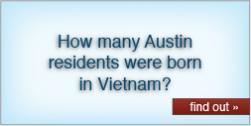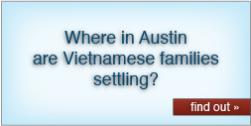How many times have you dined in authentic Asian restaurants or relaxed in nail salons where the owners and most employees are of Vietnamese descent? How much do you know about the people serving you or buffing your tips each week? As the Vietnamese population in Central Texas grows by leaps and bounds, these immigrants are transferring their culture with more than just fingernail polish and Lo Mein.
The Start of Vietnamese Growth
On April 30, 1975, the fall of Saigon ended the Vietnam War and prompted the first wave of emigration from Vietnam to America. Approximately 125,000 Vietnamese citizens fled war and danger in their native land, arriving in the United States as refugees, often with nothing but the clothes on their backs. Arriving in America wearing a native Ao Dai or just a t-shirt and jeans, the women, their children and some men found new lives. These refugees adapted to American culture and learned English at their new schools, surrounded by unfamiliar faces with few reminders of the home they left behind.
Almost 40 years later, the Asian population in Central Texas is the fastest-growing group in Austin, ranking second in size behind Houston. The U.S. Census includes Cambodian, Chinese, Filipino, Indian, Korean, Japanese and Filipino in the Asian census category.
City of Austin demographer Ryan Robinson expects this growth to continue, predicting Asians will surpass African-Americans by 2015 as the city’s second-largest minority group after Hispanics. Between 2000 and 2010, the African-American population in the Austin metro area declined from 7.7 percent to 7 percent of the population, while the Asian population increased from 3.8 percent to 4.8 percent. In 2000, there were 44,050 Asians in the Austin metro area. By 2010, that number had climbed to 82,040.
Building a Community
A number of factors have encouraged Asian immigration to Central Texas. Jobs, notably in the high-tech sector, the relatively low cost of living and the University of Texas are key factors driving the growth. But for many Vietnamese immigrants, pursuit of the classic American dream is not the primary factor bringing them to Central Texas.
Xuyen Phan is a first-generation Vietnamese immigrant who left Hue, Vietnam, with her parents and brother to escape the Communist government. The transition from one country to another was rough, but adapting wasn’t so hard, says Phan.
She earned her citizenship through her parents’ naturalization, learned English in school and adopted American culture through friends at school. “I was in ESL classes for a year. Luckily, I was still very young so I was able to pick it up very quickly. My school had a pretty large number of Vietnamese students so I did not feel like an outcast and was able to communicate most of my questions and concerns.”
Phan, who holds dual citizenship in America and Vietnam, still speaks her native language from time to time, and intends on taking her children back to her native land and teaching them her culture. She adds that the Vietnamese communities in both Austin and Houston allow her to maintain a connection with the culture and celebrations of her former home in Vietnam.
But, given the choice between staying in America or returning to Vietnam, Phan emphatically chooses “America!”
Although Austin’s Asian immigrants are not as numerous or as established as in some cities, such as Houston, their financial success has enabled them to build new centers to express their culture. Just a look at restaurants indicates the way Vietnamese culture is more integrated. In 1977, there were no more than three Chinese restaurants in Austin and the closest Vietnamese restaurant was in Houston. Today, there are 75 Vietnamese restaurants in Austin among hundreds more Chinese, sushi and Thai restaurants.
The Asian American Cultural Center also provides a connection for the Vietnamese population. The center is dedicated to providing a unique space for the sharing of Austin’s range of Asian cultures including Vietnamese, Chinese, Korean, Indian and Hawaiian. According to Center owner Amy Wong Mok, “We have so many different cultures, languages, religions, and political ideologies we really need to pay attention to those differences instead of painting all Asians in the same corner.”
The center offers classes to Asians and non-Asians alike on Asian languages, calligraphy, origami, cooking and Asian-based sports such as Kendo Japanese fencing. The Center also hosts events and historical festivals such as the Mid-Autumn Festival, Dragon Boat Festival, the heritage month of May and the Tet or Lunar New Year Festival.
Creating a Diverse Cultural Fabric
Central Texas’s appreciation of diversity and its interfaith community encourages new cultures such as the Asian community to grow and grow. There are fewer expectations on how you live, what you wear and how much you spend; it’s what you want to do rather than what’s expected of you.
If I could describe to you the feeling I had while researching the deep roots of the Vietnamese, I couldn’t sum it up in words. It’s amazing the amount of knowledge you can acquire through research, and the fun of finding out things you never knew. And I assure to you that this isn’t the last you’ll hear of the Vietnamese or any of Austin’s other immigrants groups. There will be plenty more to research and find out as the years go by and Austin continues to diversify and grow.








